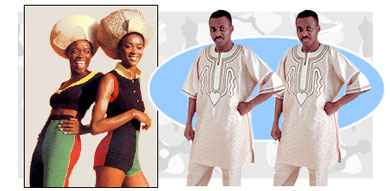Afrocentric

Fashion Synopsis
Finally freed from the constraints of segregation (at least legally), African Americans turned to their heritage as a way to express their pride and freedom. Tired of conforming to the white man’s standards of physical beauty, African Americans told the world that ‘Black is Beautiful’ and adorned themselves in traditional costumes and accessories. No longer would shame be attached to history, and black pride took to the streets.
In the 1950's, Malcom X raised his voice against racial oppression, scorning blacks who relaxed their kinky hair to the style of ‘whitey.’ The Afrocentric was quickly embraced. In the 60's, Martin Luther King Jr. gave us a dream, and the militant Black Panther Party raised their fists, but it was the hippies who opened their arms to their brothers and sisters, and shared their culture with whites.
The 60's gave rise to many different movements, and teenagers embraced clothes as a canvas for protest. It wasn’t only African-Americans who were celebrating the African heritage: white kids took to wearing African dress and accessories as a show of solidarity with their fellow man. Both races wore the boldly patterned daishiki shirt, caftans and ethnic accessories. Curly-haired whites even cultivated their own Afrocentrics.
African appreciation was not just for hippies, but they were certainly the most instrumental in embracing an outside culture and translating it to the mainstream via fashion. In 1962, “Godfather of Soul” James Brown sang “Say it Loud, I’m Black and I’m Proud,” and in 1969 jazz great Nina Simone co-wrote “Young, Gifted and Black.” These role models helped to bring the power of black pride to the people, all people, whatever color, race or creed.
The soul and funk of the 70's revived the Afrocentric and turned it into a national phenomenon. African queens gave us hair wraps and Nefertitti hats. Jamaican Rastafarians exposed us to dreadlocks and colorful knitted caps called Rasta tams. Leather emblems of Africa replaced the Mercedes symbols around the necks of ghetto kids in the 80's. ‘KABA’ outfits, with head-to-toe, heavily-decorated Kente cloth, became as common as t-shirts and jeans in the African-American community.
The awe and appreciation for the triumphant spirit and bold convictions of the African people inspired a nation to embrace cultural differences. The fashions helped to open the door, waving a flag of pride and peace in an age of turmoil. White people stepped into the shoes, dress, hat and music of the African culture and discovered they liked what they saw and heard.
Fashion Sub Categories
girl's apparelboy's apparel
